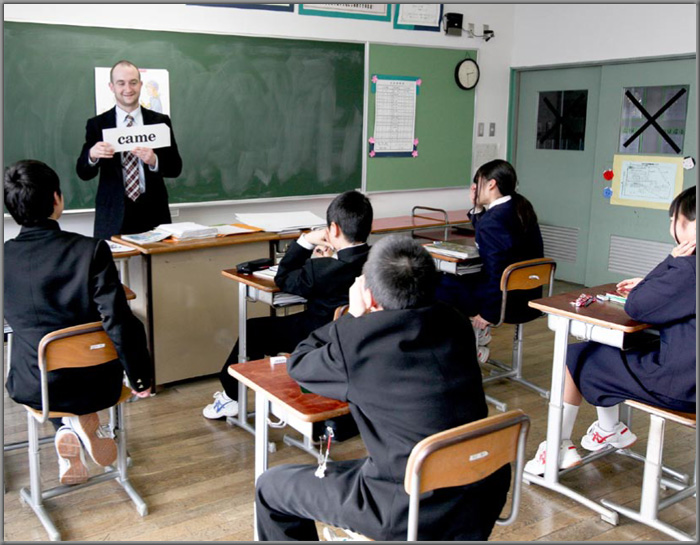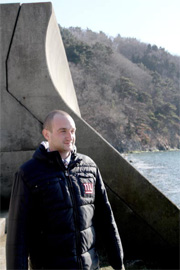Home > Highlighting JAPAN > Highlighting Japan MARCH 2012 > Bridge Building through Language
Highlighting JAPAN
COVER STORY: Rising from Adversity—TOHOKU, ONE YEAR ON

Caption: Jake Derector teaching English at the first grade of Oginohama Junior High School
Credit: YUICHI ITABASHI
Bridge Building through Language
Assistant language teachers (ALTs) play a key role in teaching foreign languages in schools throughout Japan. The Japan Journal's Osamu Sawaji introduces one American ALT, Jake Derector, and his love for the city of Ishinomaki in Miyagi Prefecture.

A 7-meter-high tsunami crashed over this breakwater in front of Oginohama Junior High School
Credit: YUICHI ITABASHI
Derector is an assistant language teacher (ALT) at Oginohama Junior High School in the Miyagi Prefecture city of Ishinomaki. The second-floor classroom is bathed in warm sunlight and looks out over a sparkling calm sea.
Five students might make for a small class, but they spend the lesson joking around, laughing and generally having fun. "Jake is really nice and his lessons are fun too!" says one of the students.
Originally from the state of Maine in the United States, Derector spent a year studying at a high school in Aomori City, Aomori Prefecture. Having made lots of friends and improved his Japanese, he made up his mind that he wanted to work in Japan in the future. After graduating from university in the United States, he was keen to become an ALT in Japan.
"When I applied, I specified that I wanted to work in the Tohoku region," says Derector. "The nature here is amazing, the food is great and the pace of life really suits me too."
Derector started teaching English as an ALT at Oginohama Junior High School and seven other junior high schools in August 2010. Located along the cove formed by the Oshika Peninsula jutting out into the Pacific Ocean, all of his schools are relatively small, with between seven and sixty-eight students.
Roughly half a year after starting work as an ALT in Ishinomaki however, the area was rocked by the Great East Japan Earthquake. The Oshika Peninsula was the nearest point to the epicenter of the earthquake on the Japanese mainland. Around thirty minutes after the quake, the area was hit by a tsunami measuring over seven meters in height. Derector was fortunately close to home and managed to evacuate to higher ground rather than getting swept away by the tsunami. All of his students managed to get to safety too. The roads into the central part of Ishinomaki however were cut off. For three days, there was no mobile phone reception and not enough food to go round.
Despite returning to the United States for a while, Derector came back to Ishinomaki as soon as classes at his schools restarted. As well as teaching, he also got involved in volunteer activities such as removing rubble.
"I'm not worried about the next earthquake, because the earthquake itself wasn't particularly dangerous," Derector says. "The tsunami that came after it was dangerous, but we can make use of our experience of the Great East Japan Earthquake to reduce the impact of the next disaster. If you run to high ground, you will not be swept away by a tsunami, even if another huge earthquake does happen."
© 2009 Cabinet Office, Government of Japan






